The Federal Hydrogen Hub Community Guide
Specific Types of Hydrogen Hub Projects That Could Impact Your Community
Learn about potential community and climate impacts, and environmental approvals
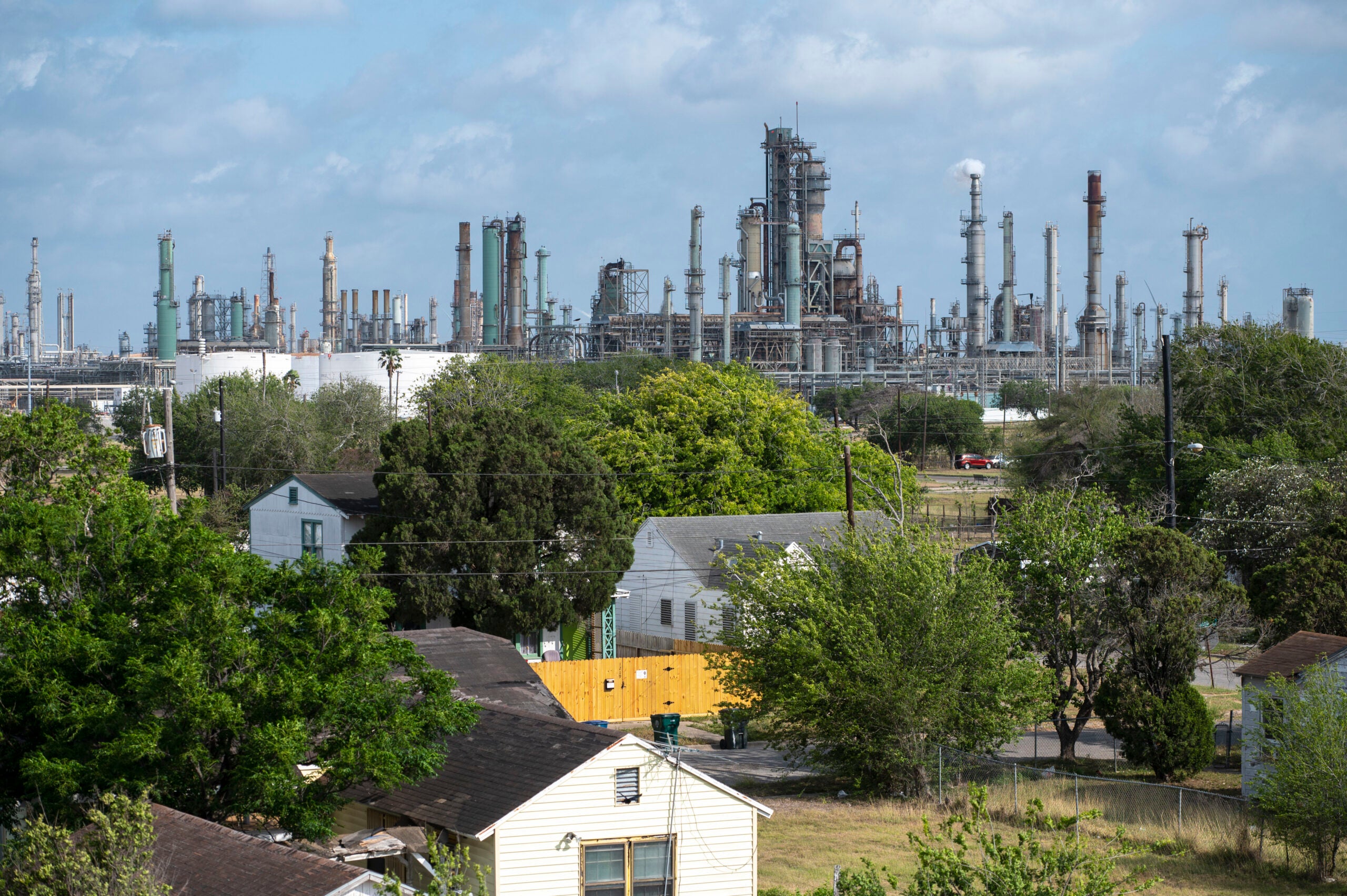
This resource is part of the Federal Hydrogen Hub Community Guide.
Each Hydrogen Hub will include a wide range of projects — from facilities that produce hydrogen, to facilities that use hydrogen, to projects that transport or store hydrogen or CO2 generated during hydrogen production.
Potential harms and benefits from specific projects will vary significantly.
Threats from a hydrogen buildout
- Hydrogen is highly flammable and prone to leaking (it’s the smallest molecule in the universe).
- Pumping hydrogen through existing gas pipelines risks leaks and explosions.
- When hydrogen leaks into the atmosphere, its climate-warming impact is nearly 12 times greater than CO2’s.
- Producing hydrogen requires a massive amount of energy. Unless that energy comes from renewables that meet strict criteria, hydrogen production will increase pollution.
- When hydrogen is burned, it emits health-harming nitrogen oxides‡.
- When hydrogen is used where we can directly electrify instead, hydrogen risks delaying the clean energy transition and making it more expensive.
This section covers types of Hydrogen Hub projects that communities are likely to face based on Hubs’ publicly announced plans and identifies potential community and climate impacts from each. As more Hub details are made available, this section will be updated.
Projects that Produce Hydrogen
Hydrogen can be produced from multiple sources, like water, fossil fuels, or biomass‡, using different kinds of technologies, like electrolysis‡ or methane reforming.
These different production methods can have substantially different community-level and climate impacts, and they are often characterized by colors, like green‡, pink‡, gray‡, or blue hydrogen‡. We discuss each of these types of hydrogen below.
Projects that Produce Hydrogen from Fossil Fuels
Impacts | Environmental Approvals
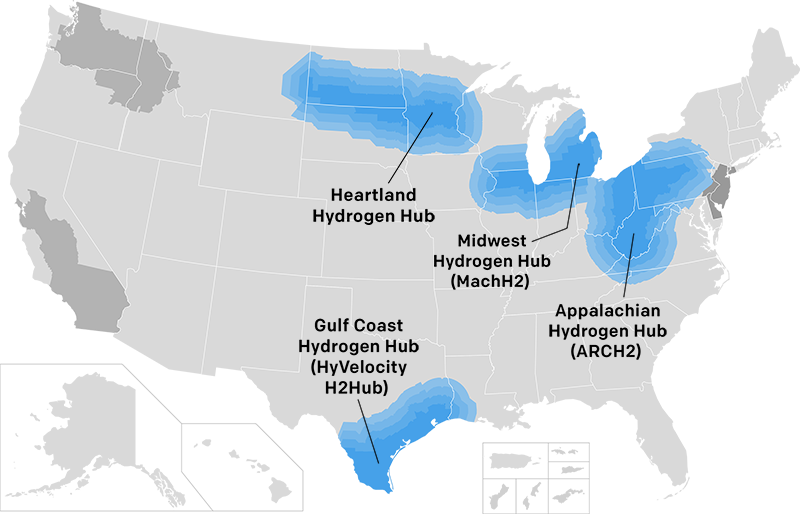
Most of the Hydrogen Hubs have announced projects that would produce hydrogen from fossil methane‡.
Hydrogen that is produced from fossil methane is often called “gray” or “blue” hydrogen.
- Gray hydrogen is made from fossil methane most often using one of two technologies: steam methane reforming (SMR)‡ or autothermal reforming (ATR)‡. Most hydrogen produced in the U.S. today — about 10 million metric tons — is gray hydrogen produced by gas companies and oil refineries.
- Blue hydrogen is also made from fossil methane through either SMR or ATR technologies. The difference between gray and blue hydrogen is that blue hydrogen includes carbon capture‡ technology.
According to publicly available information, all Hub projects that produce hydrogen from fossil fuels will be blue hydrogen projects, meaning they will include carbon capture technology.
A blue hydrogen facility is a large, industrial facility, similar to a refinery, with piping and smokestacks transporting and emitting gases.
The following table shows the community-level and climate impacts of blue hydrogen projects.
Community-Level Impact
Some existing facilities that are retrofitted with carbon capture technology may upgrade their controls for other pollutants, like sulfur dioxide and particulate matter, so that their carbon capture technology can function efficiently, which would reduce emissions of these other pollutants.
Community-Level Impact
Blue hydrogen facilities emit substantial health-harming pollution, including NOx‡, sulfur dioxide‡, particulate matter‡, carbon monoxide‡, and volatile organic compounds‡.
Carbon capture technology alone does not capture pollution other than CO2. Additionally, capturing carbon requires a lot of energy, which often comes from burning fossil fuels, further increasing air pollution in most cases.
Community-Level Impact
Because blue hydrogen facilities use methane‡ from fossil fuels, new fossil methane pipelines may be built and connected to the facility.
Community-Level Impact
Blue hydrogen facilities require large amounts of water, which could strain local water resources. Depending on the type of carbon capture technology, it may also create water pollution.
Community-Level & Climate Impact
Blue hydrogen facilities might also transport CO2 captured from their processes to a storage site.
The CO2 would likely be transported by pipeline to an off-site location, in which case all the impacts of CO2 pipelines apply along the pipeline route, as well as the impacts of CO2 storage at the storage site.
→ In this Guide: CO2 Pipelines and CO2 Storage
Climate Impact
Blue hydrogen facilities emit substantial climate-warming pollution, like CO2 and methane. Carbon capture technology does not capture all CO2 emissions.
Only a few blue hydrogen facilities operate today, and their CO2 capture rates are between 40 and 70%. It also does not capture other greenhouse gas emissions, such as methane.
Climate Impact
Extracting fossil methane and transporting it to the production site produces methane emissions.
Climate Impact
Because hydrogen is an indirect greenhouse gas, hydrogen leaks from these facilities will contribute to climate change.
→ In this Guide: Hydrogen Pipelines
Environmental Approvals
A blue hydrogen facility will need:
- Air permits to address air pollution (both an operating permit and either a construction or modification permit)
- An NPDES permit for discharging polluted water
A blue hydrogen facility might need:
- An environmental impact review under federal NEPA and/or similar state laws
- A Section 404 permit if the facility is constructed near a waterway or wetland, as well as state 401 permits under the Clean Water Act
- Land use approvals
- Permits under the Rivers and Harbors Act if dredging and/or filling of watered areas is needed
- A Class VI permit for injecting CO2 into wells for underground storage
- Approvals under the Endangered Species Act
- Approvals under the National Historic Preservation Act
- Approvals if it plans to seek other federal subsidies, like federal tax credits for producing “clean” hydrogen or for capturing and storing CO2, or state or local subsidies
- Depending on the state, additional permits beyond those required by the federal government
Projects that Produce Hydrogen from Water
Impacts | Environmental Approvals
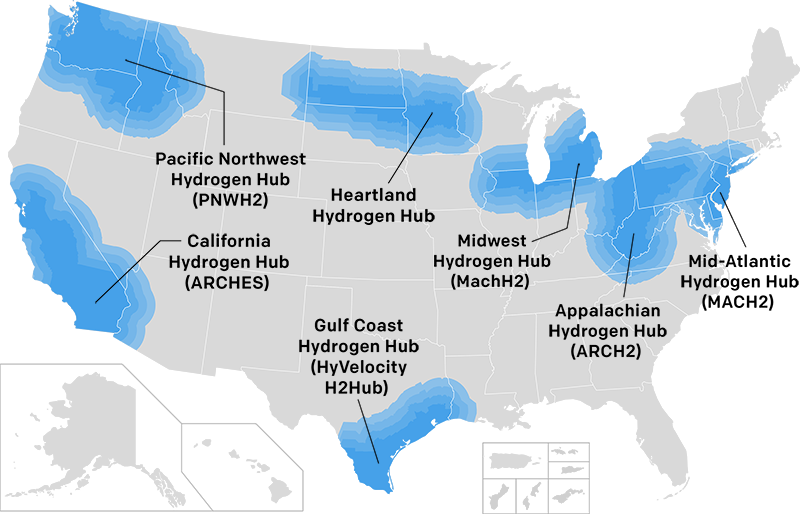
All of the Hydrogen Hubs have announced some projects that would produce hydrogen by using energy to extract it from water.
Hydrogen that is produced from water is often called “green” or “pink” hydrogen.
- Green hydrogen‡ is made using 100% renewable electricity — like solar and wind — to split hydrogen from water molecules through a process called electrolysis‡, using a technology called an electrolyzer.
- Pink hydrogen is the same as green, except that nuclear energy‡ is used to power the electrolyzer instead of renewable electricity.
Unlike the technologies used to produce gray or blue hydrogen (SMR/ATR), which produce substantial pollution from dirty feedstocks, an electrolyzer produces only hydrogen and oxygen and the feedstocks are water and electricity.
Truly Clean Hydrogen Production
Producing hydrogen from water through electrolysis requires an immense amount of energy. Green‡ or pink hydrogen‡ can only be produced without massive CO2 emissions and other pollution if it uses sources of clean energy that are “new, now, and near.” These criteria are often called the “three pillars” of clean hydrogen production:
- New — The electrolyzer‡ is powered by new, not existing, renewable sources of energy. This requirement is often called “additionality” or “incrementality.” Some would propose that this requirement is met when an electrolyzer is powered by a nuclear plant that increases its energy production rather than new renewables. In that case, the impacts of increased nuclear energy production‡ must be considered.
- Now — Those new renewable sources produce electricity during the same hours that the electrolyzer is running. This requirement is often called “hourly matching” or “temporal matching.”
- Near — Those new renewable sources are located near the electrolyzer and can deliver power to the process. This requirement is often called “deliverability.”
Without these three pillars, green or pink hydrogen production will divert enormous amounts of zero-carbon electricity that is already in use. Making up for this loss will require more electricity from fossil fuel power plants. This is true even if the hydrogen project claims it will run its electrolyzer on only zero-carbon electricity.
- Additionality ensures that we don’t divert existing zero-carbon electricity from the grid or other uses to power hydrogen production.
- Hourly matching and deliverability account for the fact that the emissions impact of running an electrolyzer depends on time and location.
Some parts of our grid get more electricity from fossil fuel power plants than other parts. Likewise, our electric grid depends more on fossil fuel power plants at certain hours of the day. Hourly matching and deliverability ensure that electrolyzers only run when and where zero-carbon resources are actually providing zero-carbon electricity to the grid.
A green or pink hydrogen facility will mostly consist of a warehouse-like building housing one or more electrolyzers. The electricity produced to power the electrolyzer(s) may be located on or off-site.
A major concern with green and pink hydrogen is whether the zero-carbon electricity used to power the electrolyzer is diverted from the electric grid. Zero-carbon energy diverted from the grid has to be replaced, and most often it is replaced with dirty fossil energy, increasing community-level and climate pollution in the communities that host fossil fuel power plants. In this case, hydrogen produced from water is not clean. A related concern is the highly inefficient use of zero-carbon electricity to produce green or pink hydrogen for uses that can be electrified instead.
Community-Level Impact
Green hydrogen can be made without causing community-level pollution only if it is truly clean hydrogen — meaning the production process is powered by sources of clean energy that are “new, now, and near.”‡
Community-Level Impact
If it is not truly clean hydrogen‡, green hydrogen production would cause dirty fossil fuel power plants to run longer and/or more frequently, significantly increasing local air pollution around those plants.
Community-Level Impact
Pink hydrogen production will involve all the potential local health risks of nuclear energy production and will cause the same indirect impacts as green hydrogen unless it is powered by sources of clean energy that are “new, now, and near.”
Community-Level Impact
Producing hydrogen from water requires large amounts of water, which could strain local water resources.
Climate Impact
Green and pink hydrogen production will cause significant increases in CO2 pollution unless they are powered by sources of clean energy that are “new, now, and near.”
Climate Impact
Green and pink hydrogen production risks wasting large amounts of zero-carbon electricity.
Electrolysis requires a tremendous amount of electricity, and it is always more efficient to directly use zero-carbon electricity where possible than to use it to produce hydrogen.
Climate Impact
Because hydrogen is an indirect greenhouse gas, hydrogen leaks from these facilities will contribute to climate change.
→ In this Guide: Hydrogen Pipelines
Environmental Approvals
A green or pink hydrogen facility might need:
- An environmental impact review under NEPA and/or similar state laws
- Land use approvals
- Approvals if it plans to seek other federal subsidies, like federal tax credits for producing “clean” hydrogen, or state or local subsidies
Projects that Produce Hydrogen from Biomass
Impacts | Environmental Approvals

The Appalachian Hydrogen Hub (ARCH2) in West Virginia, Ohio, and Pennsylvania and the California Hydrogen Hub (ARCHES) propose to produce hydrogen from biomass‡.
According to DOE, biomass includes:
- agriculture crop residues,
- forest residues,
- crops grown specifically for energy use,
- organic municipal solid waste, and
- animal waste.
These waste streams can be converted into hydrogen via various chemical processes, depending on the starting material.
- Solid biomass (like forest residues) will typically undergo a gasification‡ or pyrolysis process that requires high heat and pressure.
- Gaseous waste streams (e.g., landfill, sewage, or animal waste biogas‡) can be upgraded (e.g. cleaned of impurities) before undergoing SMR‡ or ATR‡ just like fossil methane.
→ In this Guide: Projects that produce hydrogen from fossil fuels
A biomass hydrogen facility is large and looks like a refinery, with piping and smokestacks transporting and emitting gases that are part of the process.
Community-Level Impact
Biomass-to-hydrogen facilities will emit health-harming pollution because they process carbon-based fuels at high temperatures and pressures to create hydrogen.
The exact pollutants and amount of emissions will depend on the biomass used and control technologies‡ implemented at the facility. Pollutants may include but are not limited to NOx‡, particulate matter‡, and carbon monoxide‡.
Community-Level Impact
Transporting biomass to the hydrogen production facility will likely involve increased trucking in the area, which will increase local air and noise pollution, and may have impacts on traffic and quality of life.
Community-Level Impact
Pre-processing of biomass‡ to prepare it for use in a hydrogen production facility may create significant local air and water pollution. This may occur at the production site or a separate site.
Community-Level Impact
If the facility uses carbon capture‡ technology, there may be additional air pollution impacts because the technology requires a lot of energy, which often comes from burning more fossil fuels. Carbon capture technology also increases water use and may increase water pollution.
Community-Level & Climate Impact
Biomass-to-hydrogen facilities might also transport CO2 captured from their processes to a storage site. The CO2 would likely be transported by pipeline to an off-site location, in which case all the impacts of CO2 pipelines apply along the pipeline route, as well as the impacts of CO2 storage‡ at the storage site.
→ In this Guide: CO2 Pipelines and CO2 Storage
Climate Impact
All biomass-to-hydrogen facilities will directly emit climate-warming pollution, like CO2 and methane.
Climate Impact
Biomass-to-hydrogen production often causes indirect climate-warming emissions through the production of biomass‡. This is true of the production of landfill, sewage, and animal waste biogas‡. Appropriate waste and manure management practices lead to small amounts of unavoidable waste biogas that are most effectively used directly as fuel rather than to power hydrogen production.
The production of hydrogen from crop and forest residues can increase climate-warming emissions if it causes harmful land use changes, such as deforestation.
Biogas and biomethane supply chains have also been shown to leak at much higher rates than even the fossil methane supply chain. If biogas or biomethane is intentionally produced (e.g. from poor manure management practices), then net leakage could offset the climate benefit of replacing fossil methane. Avoiding the creation of methane‡ in the first instance is the best option
Climate Impact
Because hydrogen is an indirect greenhouse gas, hydrogen leaks from these facilities will contribute to climate change.
→ In this Guide: Hydrogen Pipelines
Environmental Approvals
A biomass-to-hydrogen facility will need:
- Air permits to address air pollution (both an operating permit and either a construction or modification permit)
- An NPDES permit for discharging polluted water
A biomass-to-hydrogen facility might need:
- An environmental impact review under federal NEPA and/or similar state laws
- A Section 404 permit if the facility is constructed near a waterway or wetland, as well as state 401 permits under the Clean Water Act
- Land use approvals
- Permits under the Rivers and Harbors Act if dredging and/or filling of watered areas is needed
- A Class VI permit for injecting CO2 into wells for underground storage
- Approvals under the Endangered Species Act
- Approvals under the National Historic Preservation Act
- Approvals if it plans to seek other federal subsidies, like federal tax credits for producing “clean” hydrogen or for capturing and storing CO2, or state or local subsidies
- Depending on the state, additional permits beyond those required by the federal government
Projects that Use Hydrogen
Projects that use hydrogen can also impact communities and the climate in a variety of ways.
This section describes potential impacts — positive and negative — from various hydrogen uses that have been proposed by the Hydrogen Hubs.
Power Generation
Power Plants
Impacts | Environmental Approvals

All of the Hydrogen Hubs are proposing to use hydrogen to generate electricity at power plants.
Generating power from hydrogen likely involves burning hydrogen or a mix of hydrogen and methane‡.
These facilities will likely be existing power plants that already use fossil methane as a fuel, where some portion of the fossil methane will be substituted with hydrogen. New hydrogen-fueled power plants might also be proposed as part of the Hubs.
Community-Level Impact
Burning hydrogen in a power plant will increase NOx‡ emissions.
Currently, pollution control technologies‡ can minimize, but not eliminate, this increase. One industry study found that burning a 50/50 mix of hydrogen and methane could increase NOx emissions by 35%.
A recent air permit for a proposed hydrogen-fueled power plant in Indiana suggests emissions could be even higher; that permit set NOx limits for hydrogen combustion 3x higher than the limits for burning methane.
NOx emissions can aggravate respiratory diseases, particularly asthma.
Community-Level Impact
Transporting hydrogen to a power plant might increase trucking in the area, which will increase local air and noise pollution.
It might also require new pipelines, in which case all impacts from hydrogen pipelines would apply.
→ In this Guide: Hydrogen Pipelines
Community-Level Impact
Depending on how it is produced, hydrogen can be expensive compared to other fuels and thus combusting hydrogen at power plants may increase local energy bills.
Climate Impact
Power plants that burn hydrogen can produce CO2 emissions.
Although burning 100% hydrogen does not produce CO2 emissions, power plants won’t burn pure hydrogen, at least in the short term. Instead, they will burn a blend of hydrogen and methane.
A plant that burns methane will continue to produce CO2. There is not a 1:1 relationship between the amount of hydrogen burned and CO2 reduced.
In order to reduce a power plant’s CO2 emissions by 50%, that plant would need to burn at least 75% hydrogen.
Climate Impact
Using renewable electricity directly is much more efficient than using renewable electricity to create hydrogen, and then burning that hydrogen for power.
For example, roughly 2/3 of energy is lost when renewable electricity is used to produce hydrogen that is burned in a power plant.
Climate Impact
Because hydrogen is an indirect greenhouse gas, hydrogen leaks from these facilities will contribute to climate change.
→ In this Guide: Hydrogen Pipelines
Environmental Approvals
A hydrogen-fueled power plant will need:
- Air permits to address air pollution (both an operating permit and either a construction or modification permit)
- An NPDES permit for discharging polluted water
A hydrogen-fueled power plant might need:
- An environmental impact review under federal NEPA and/or similar state laws
- A Section 404 permit if the facility is constructed near a waterway or wetland, as well as state 401 permits under the Clean Water Act
- Land use approvals
- Approvals under the Endangered Species Act
- Approvals under the National Historic Preservation Act
- Approvals from the state agency overseeing electric utilities, often called the Public Service Commission or Public Utility Commission
- Additional approvals if it plans to seek other federal, state, or local subsidies
If a Hydrogen Hub proposes to use hydrogen at an existing power plant, some requirements may be addressed by existing permits.
Power Generation
Heating for Buildings
Like hydrogen mixed with methane‡ at power plants, hydrogen could be mixed with methane in systems that use boilers to heat homes or commercial buildings. This could cause many of the same impacts as burning hydrogen at a power plant — such as increased NOx‡ emissions — except that people would experience those impacts in their homes and other buildings.
Just as generating electricity from renewable resources like wind and solar is more efficient than generating electricity from hydrogen-fueled power plants, electric heat pumps‡ are more efficient, cleaner, and safer than burning hydrogen for heat. It takes about five times more electricity to heat a home with green hydrogen‡ than it takes to heat the same home with an efficient heat pump.
Power Generation
Fuel Cells
Impacts | Environmental Approvals
Hydrogen fuel cells produce electricity by combining hydrogen and oxygen atoms.
- The hydrogen and oxygen react across an interface, similar to a battery, and produce electricity, water, and small amounts of heat.
- Unlike using hydrogen in power plants to generate electricity or in boilers to heat homes, where hydrogen is burned, hydrogen used in fuel cells is not burned.
Fuel cells range in size.
- Some are small enough to fit inside of a car,
- Some are big enough to power a single home, and
- Others may be big enough to power the equivalent of hundreds of homes.
Community-Level Impact
Unlike using hydrogen in power plants or boilers, using hydrogen in fuel cells is a way to store clean energy without producing air pollution since fuel cells do not burn hydrogen.
Community-Level Impact
Like power plants, hydrogen fuel cells will need a steady stream of hydrogen to feed their operations.
- Transporting hydrogen to a power plant might increase trucking in the area, which will increase local air and noise pollution.
- It might also require new pipelines, in which case all impacts from hydrogen pipelines would apply.
→ In this Guide: Hydrogen Pipelines
Climate Impact
The climate impacts of hydrogen fuels cells will depend on how the hydrogen is delivered to the site (e.g. pipeline, truck), and how much hydrogen leaks into the atmosphere.
Climate Impact
Using renewable energy directly is more efficient than using renewable energy to create hydrogen, and then converting the hydrogen back to electricity in a fuel cell.
Climate Impact
Because hydrogen is an indirect greenhouse gas, hydrogen leaks from these facilities will contribute to climate change.
→ In this Guide: Hydrogen Pipelines
Environmental Approvals
Hydrogen fuel cells might need:
- Land use approvals
- Additional approvals if the project developer plans to seek other federal, state, or local subsidies
Industrial Sector
Some hydrogen hub projects will use hydrogen to make other fuels or end products.
Industrial Sector
Oil Refineries
Impacts | Environmental Approvals
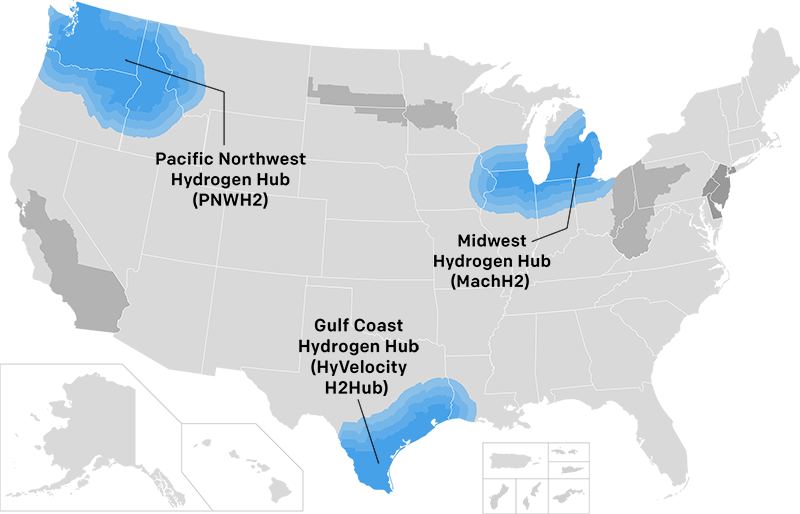
Today, oil refineries use hydrogen to lower the sulfur content of diesel fuel. In fact, about 60% of current U.S. hydrogen demand comes from crude oil refineries.
Some oil refineries produce hydrogen on-site from fossil methane, while others get it delivered (e.g. by pipeline or truck) from off-site production facilities.
Community-Level Impact
For oil refineries that produce hydrogen on-site, replacing hydrogen made from fossil fuels (gray‡ or blue hydrogen‡) with hydrogen made from water (green hydrogen‡) will reduce refineries’ health-harming emissions, as long as the green hydrogen is truly clean‡.
Climate Impact
Replacing gray or blue hydrogen production with green hydrogen production may reduce impacts from transporting fossil methane‡ to the refinery site.
Climate Impact
For oil refineries that produce hydrogen on-site, replacing hydrogen made from fossil fuels (gray or blue hydrogen) with hydrogen made from water (green hydrogen) will reduce refineries’ climate-warming emissions, as long as the green hydrogen is truly clean‡.
This type of replacement is an important piece of any decarbonization pathway for oil refineries.
Community-Level Impact
Oil refineries emit substantial health-harming pollution, including NOx‡, particulate matter‡, SO2‡, and volatile organic compounds‡.
Community-Level Impact
Transporting hydrogen to a refinery might increase trucking in the area, which will increase local air and noise pollution.
It might also require new pipelines, in which case all impacts from hydrogen pipelines would apply.
→ In this Guide: Hydrogen Pipelines
Climate Impact
Oil refineries release substantial climate-warming pollutants like CO2 and methane‡.
Climate Impact
Because hydrogen is an indirect greenhouse gas, hydrogen leaks from these facilities will contribute to climate change.
→ In this Guide: Hydrogen Pipelines
Environmental Approvals
Oil refineries will need:
- Air permits to address air pollution (both an operating permit and either a construction or modification permit)
- An NPDES permit for discharging polluted water
Oil refineries might need:
- An environmental impact review under federal NEPA and/or similar state laws
- Land use approvals
- Additional approvals if planning to seek other federal, state, or local subsidies
If a Hydrogen Hub proposes to retrofit a refinery with hydrogen infrastructure, some requirements may be addressed by existing permits.
Industrial Sector
Ammonia Production
Impacts | Environmental Approvals
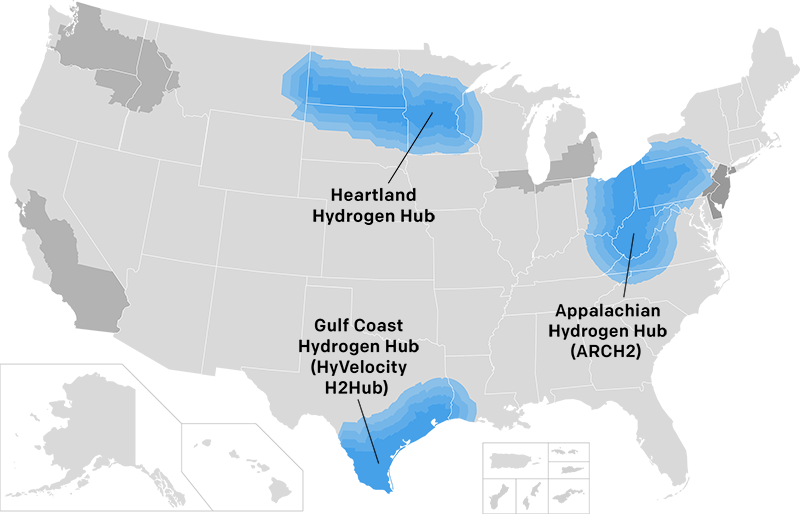
Ammonia‡ is used primarily in agriculture as fertilizer. More recently, ammonia has been discussed as a possible marine shipping fuel.
Much existing hydrogen production takes place at ammonia production facilities, which look like large, industrial facilities with piping and smokestacks transporting and/or emitting the different gases that are part of the process.
At large scales, ammonia (NH3) is produced from hydrogen and nitrogen through a chemical reaction. The reaction runs at high temperature and pressure and requires a lot of energy.
Climate Impact
For ammonia production facilities that make hydrogen on-site, replacing hydrogen made from fossil fuels (gray‡ or blue hydrogen‡) with hydrogen made from water (green hydrogen‡) will reduce climate-warming emissions, as long as the green hydrogen is truly clean‡.
Community-Level Impact
The ammonia production facility will emit health-harming air pollutants when it burns fossil fuels to create the high temperature and pressure needed for the chemical reaction that produces ammonia.
Community-Level Impact
If the ammonia production facility also makes hydrogen from fossil fuels on-site, then all the impacts associated with producing hydrogen from fossil fuels apply.
Community-Level Impact
These facilities also emit large amounts of health-harming ammonia.
- Exposure to ammonia can irritate the nose, throat, and respiratory tract, which can also lead to respiratory issues.
- Chronic exposure increases risk of respiratory irritation, asthma symptoms, and impaired lung function.
- Studies suggest that exposure to high levels of ammonia may adversely affect the liver, kidney, and spleen. Ammonia also transforms into secondary PM2.5 (ammonium sulfate, ammonium nitrate, and ammonium chloride), causing the same health effects associated with exposure to particulate matter‡.
Community-Level Impact
Transporting hydrogen to a power plant might increase trucking in the area, which will increase local air and noise pollution.
It might also require new pipelines, in which case all impacts from hydrogen pipelines would apply.
→ In this Guide: Hydrogen Pipelines
Climate Impact
The chemical reaction that produces ammonia does not directly emit CO2.
However, the ammonia production facility will emit CO2 when it burns fossil fuels to create the high temperature and pressure needed for the chemical reaction that produces ammonia.
Climate Impact
Ammonia production requires nitrogen. Nitrogen may be produced on-site, which would require an energy-intensive air separation unit that will have its own environmental and climate impacts.
Climate Impact
Because hydrogen is an indirect greenhouse gas, hydrogen leaks from these facilities will contribute to climate change.
→ In this Guide: Hydrogen Pipelines
Environmental Approvals
Ammonia production facilities will need:
- Air permits to address air pollution (both an operating permit and either a construction or modification permit)
- An NPDES permit for discharging polluted water
Ammonia production facilities might need:
- An environmental impact review under federal NEPA and/or similar state laws
- Land use approvals
- Additional approvals if planning to seek other federal, state, or local subsidies
If a Hub project proposes to retrofit an existing ammonia production facility, some requirements may be addressed by existing permits.
Industrial Sector
Methanol Production
Impacts | Environmental Approvals
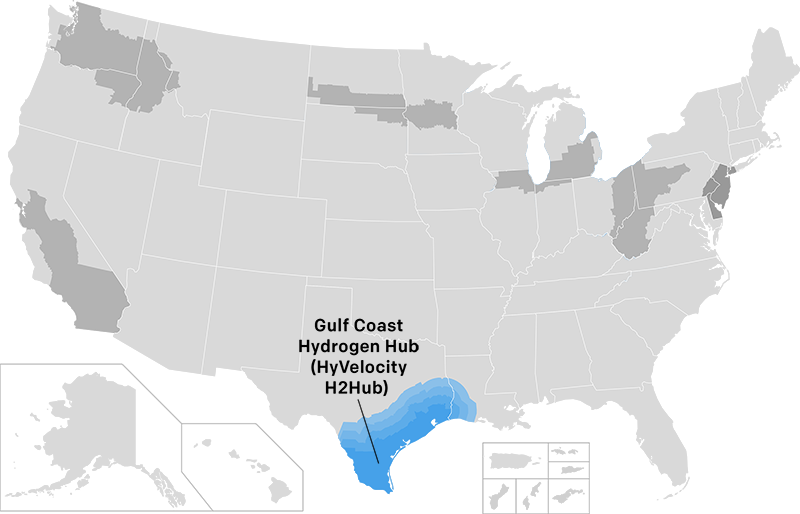
Proposed uses for methanol include engine fuel and marine shipping fuel, among others.
Under the right conditions, hydrogen and carbon oxides (CO‡, CO2) can react to form methanol (CH3OH).
Today, methanol is produced almost exclusively using gray hydrogen‡.
- Hub projects might produce methanol using blue hydrogen‡. This type of methanol is often called “blue” methanol.
- It is also possible that Hub projects will produce so-called “green” methanol (or e-methanol). While it has not yet been done at large scale, some are proposing to produce e-methanol using green hydrogen‡ and CO2 captured from facilities that burn fossil fuels. E-methanol is one of several e-fuels discussed as a possible alternative to fossil fuels. None of these e-fuels have been produced at scale.
Methanol production facilities look like large, industrial facilities with piping and smokestacks transporting and/or emitting the different gases that are part of the process.
Climate Impact
For methanol production facilities that make hydrogen on-site, replacing hydrogen made from fossil fuels (gray‡ or blue hydrogen‡) with hydrogen made from water (green hydrogen‡) will reduce climate-warming emissions, as long as the green hydrogen is truly clean‡.
Community-Level Impact
If the methanol production facility also makes hydrogen from fossil fuels on-site, then all the impacts associated with producing hydrogen from fossil fuels apply.
The facility may also emit methanol and VOCs‡, especially if the liquid methanol is stored on-site before transport.
Community-Level Impact
Transporting hydrogen to a power plant might increase trucking in the area, which will increase local air and noise pollution.
It might also require new pipelines, in which case all impacts from hydrogen pipelines would apply.
→ In this Guide: Hydrogen Pipelines
Climate Impact
Because hydrogen is an indirect greenhouse gas, hydrogen leaks from these facilities will contribute to climate change.
→ In this Guide: Hydrogen Pipelines
Environmental Approvals
Methanol production facilities will need:
- Air permits to address air pollution (both an operating permit and either a construction or modification permit)
- An NPDES permit for discharging polluted water
Methanol production facilities might need:
- An environmental impact review under federal NEPA and/or similar state laws
- Land use approvals
- Additional approvals if planning to seek other federal, state, or local subsidies
If a Hub project proposes to retrofit an existing methanol production facility, some requirements may be addressed by existing permits.
Industrial Sector
Sustainable Aviation Fuel (SAF) Production
Impacts | Environmental Approvals
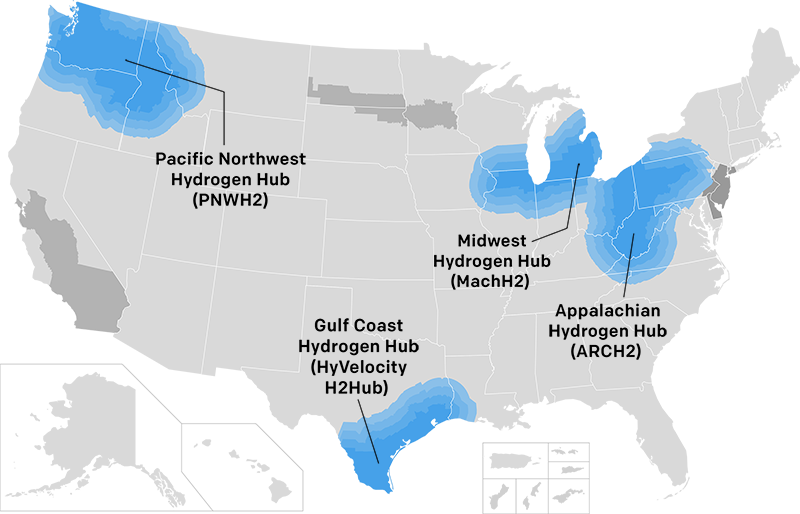
Sustainable Aviation Fuel is a general term for alternative jet fuels made from a variety of carbon-based feedstocks such as:
- agricultural and forestry residue
- organic municipal solid waste
- fats, oils, and greases from cooking waste and meat production
- algae
- industrial carbon monoxide‡ or CO2 waste gas
Of these, hydrogen only plays a major role in CO2 waste gas, when carbon captured from industrial facilities is used as the carbon-based feedstock.
- Under high temperatures and pressures, which could come from burning fossil fuels, carbon-based feedstock and hydrogen can react to produce jet fuels, sometimes called eSAF.
Facilities that produce eSAF will likely look like industrial facilities with piping and smokestacks transporting and/or emitting the different gases that are part of the process.
Community-Level Impact
eSAF production will require a steady stream of CO2 and hydrogen, both of which may be delivered to a site via new pipelines, in which case all the impacts from hydrogen and CO2 pipelines apply.
→ In this Guide: Hydrogen Pipelines and CO2 Storage
Both gases could also be transported to the facility by truck, which might increase trucking in the area, and with it, increase local air and noise pollution.
eSAF production requires high temperatures and pressures which may require burning fossil fuels, which emits various health-harming pollutants.
Climate Impact
eSAF production is an emerging industry and its total climate impacts are unclear. However, as with other hydrogen projects, hydrogen leaks from these facilities will contribute to climate change, because hydrogen is an indirect greenhouse gas.
→ In this Guide: Hydrogen Pipelines
Environmental Approvals
eSAF production facilities will need:
- Air permits to address air pollution (both an operating permit and either a construction or modification permit)
- An NPDES permit for discharging polluted water
eSAF production facilities might need:
- An environmental impact review under federal NEPA and/or similar state laws
- A Section 404 permit if constructing the facility would take place near a waterway or wetland
- Land use approvals
- Approvals under the Endangered Species Act
- Approvals under the National Historic Preservation Act
- Additional approvals if planning to seek other federal, state, or local subsidies
Industrial Sector
Steel Production
Impacts | Environmental Approvals

Steel production accounts for about 1% of total U.S. greenhouse gas emissions and is widely considered to be hard to decarbonize due to the high heat required throughout the production process.
Hydrogen may be used to replace fossil fuels at some steel mills as a means of lowering greenhouse gas emissions.
Community-Level Impact
Replacing fossil fuels like coal and fossil methane at steel mills with hydrogen made from water (green hydrogen) will reduce mills’ health-harming emissions, as long as the green hydrogen is truly clean‡.
Community-Level Impact
Replacing fossil fuels with green hydrogen‡ may reduce impacts from transporting fossil fuels to the site.
Climate Impact
To the extent steel mills replace fossil fuels with green hydrogen‡ that is truly clean‡, then they will reduce their climate-warming emissions.
This type of replacement is an important piece of any decarbonization pathway for steel manufacturing.
Community-Level Impact
Steel mills emit substantial health-harming pollution, including NOx‡, particulate matter‡, SO2‡, and volatile organic compounds‡.
Community-Level Impact
Transporting hydrogen to a steel mill might increase trucking in the area, which will increase local air and noise pollution.
It might also require new pipelines, in which case all impacts from hydrogen pipelines would apply.
→ In this Guide: Hydrogen Pipelines
Climate Impact
Steel mills release substantial climate-warming pollutants like CO2 and methane‡.
Climate Impact
Because hydrogen is an indirect greenhouse gas, hydrogen leaks from these facilities will contribute to climate change.
→ In this Guide: Hydrogen Pipelines
Environmental Approvals
Steel mills will need:
- Air permits to address air pollution (both an operating permit and either a construction or modification permit)
- An NPDES permit for discharging polluted water
Steel mills might need:
- An environmental impact review under federal NEPA and/or similar state laws
- Land use approvals
- Additional approvals if planning to seek other federal, state, or local subsidies
If a Hub project proposes to retrofit a steel mill with hydrogen infrastructure, some requirements may be addressed by existing permits.
Projects that Transport or Store Hydrogen or CO2
Transport Hydrogen
Hydrogen Pipelines
Impacts | Environmental Approvals

While four of the seven Hydrogen Hubs have announced plans to build new hydrogen pipelines, it is likely that all Hubs will need hydrogen pipeline infrastructure.
Regulation of hydrogen pipelines
Hydrogen pipelines are very limited. There are only about 1,600 miles of hydrogen pipelines in the U.S. today, mostly clustered in Southern California and along the Gulf Coast in Texas and Louisiana, compared to millions of miles of methane pipelines across the country. Unchecked, a hydrogen economy could lead to a massive buildout of new hydrogen pipelines.
Regulation of hydrogen pipelines must be strengthened to adequately protect communities. The U.S. Department of Transportation’s Pipeline and Hazardous Materials Safety Administration (PHMSA) oversees hydrogen pipeline safety and has acknowledged challenges and uncertainties regarding the safe transport of hydrogen by pipeline. PHMSA has indicated that it's evaluating its hydrogen pipeline regulations but has not committed to strengthening them.
Hydrogen pipelines function like methane‡ pipelines, but there are substantial differences between methane and hydrogen that must be accounted for in these new pipelines.
- Hydrogen is a smaller, lighter, and more reactive molecule than methane, which makes it more prone to leaking out of pipelines than methane.
- Hydrogen can also cause embrittlement issues in some pipeline materials used to transport methane (meaning hydrogen creates small cracks in the metal that can lead to more significant cracking).
It is important that hydrogen pipelines use different materials that address these leakage and embrittlement risks.
New pipelines would need to be built if hydrogen is to be transported safely. Existing methane pipelines will not be effective.
Community-Level Impact
Hydrogen behaves very differently than fossil methane and is more prone to leaking, exploding, and burning.
Community-Level Impact
Pipelines rely on compressor stations to maintain flow, which can cause air pollution near these stations, depending upon how they are fueled.
Community-Level Impact
Pipeline installation can cause habitat and farmland destruction and can involve taking private property without public benefit.
Climate Impact
Hydrogen is an indirect greenhouse gas.
Through a series of chemical reactions, hydrogen increases the amount of greenhouse gases, like methane, in the atmosphere. Scientists have estimated that hydrogen has nearly 12 times the warming impact of CO2 over a 100-year period.
Any substantial hydrogen pipeline leaks would have climate implications.
Environmental Approvals
The construction and/or operation of a hydrogen pipeline might need some or all of the following approvals, depending on its location and whether it crosses state lines:
- An environmental impact review under federal NEPA and/or similar state laws
- Clean Air Act approvals if the pipeline relies on compressor stations powered by fossil fuels. A compressor station is an industrial facility that maintains the flow of gas through a pipeline.
- A Section 404 permit if constructing the pipeline would take place near a waterway or wetland
- Land use approvals
- Approvals under the Endangered Species Act
- Approvals under the National Historic Preservation Act
- Permits and approvals required under state law
Store Hydrogen
Hydrogen Storage and Fueling Stations
Impacts | Environmental Approvals

Each Hydrogen Hub will need to store some amount of hydrogen, either as a gas or liquid.
Storage facilities can vary widely, ranging from tanks to the few geologic salt caverns in the U.S. that have been proposed for underground storage of hydrogen.
- Different types of hydrogen storage present different challenges, such as high costs, inadequate space (storing gaseous hydrogen requires large amounts of space), and inefficiencies (converting hydrogen to a liquid, then back to a gas, results in energy loss).
- Some storage methods are in the very early stages of research and development and a lot is still unknown about their reliability and potential impacts.
Electric vehicles vs. fuel cell vehicles
Battery-electric vehicles are generally a better option for decarbonizing our transportation sector than hydrogen fuel cell vehicles.
Only about 25% of renewable electricity used to produce hydrogen makes it to the wheels of a hydrogen fuel cell vehicle, compared to 75% in a battery-electric vehicle.
While hydrogen fuel cells could help decarbonize our heaviest duty trucks with the longest routes, battery electric vehicles are a more efficient option for most other types of road transportation.
Hubs have provided limited information on their hydrogen storage plans. However, four of the seven Hydrogen Hubs include building new hydrogen fueling stations, and six of seven Hubs propose to use hydrogen in the transportation sector, which will likely also require hydrogen fueling stations. Hydrogen fueling stations are essentially a type of hydrogen storage.
The potential impacts of hydrogen fueling stations are described in the below table.
Community-Level Impact
Existing fueling stations that switch from fueling diesel vehicles to fueling hydrogen vehicles could reduce local air pollution.
It is important to consider whether electric vehicles are also an option and, if so, to evaluate whether battery-electric vehicles would provide greater community-level (and climate) benefits than hydrogen fuel cell vehicles.
Climate Impact
Replacing diesel with hydrogen at fueling stations could reduce greenhouse gas emissions, depending on how the hydrogen is produced and transported to the fueling station.
Community-Level Impact
New hydrogen fueling stations could increase truck traffic in communities, which would increase local air and noise pollution.
Community-Level Impact
Hydrogen is more prone to leaking, exploding, and burning than many other liquid fuels, including methane‡ and propane.
Climate Impact
Because hydrogen is an indirect greenhouse gas, hydrogen leaks from these facilities will contribute to climate change.
→ In this Guide: Hydrogen Pipelines
Environmental Approvals
A hydrogen fueling station may need land use approvals. An existing fueling station that switches to hydrogen fuel is less likely to need approvals.
Transport CO2
CO2 Pipelines
Impacts | Environmental Approvals

The four Hydrogen Hubs that plan to produce hydrogen from fossil fuels using carbon capture‡ technology (blue hydrogen‡) will likely need to build and operate pipelines to transport CO2 captured from the blue hydrogen facility.
As of 2022, approximately 5,000 miles of CO2 pipelines exist in the U.S. — far fewer than the over 220,000 miles of pipelines that carry other hazardous liquids.
- Existing CO2 pipelines generally serve enhanced oil recovery operations — which is when CO2 is used to pump more oil out of the ground — and these pipelines are only loosely regulated.
- The Pipeline and Hazardous Materials Safety Administration (PHMSA) has committed to updating CO2 pipeline regulations, but the proposed rule is not yet public.
Existing CO2 pipelines mostly transport CO2 produced from underground sources, rather than CO2 produced by burning fossil fuels. It may be difficult to remove all impurities when CO2 is captured from processes that burn fossil fuels, and these impurities could create risks within pipelines.
Community-Level Impact
CO2 leaks could be harmful because CO2 is an asphyxiant, meaning it displaces oxygen and can cause suffocation.
It is heavier than air, so it stays close to the ground, and can travel large distances at high concentrations from a ruptured pipeline.
CO2 leaks can also prevent combustion vehicles (as opposed to battery-electric vehicles) from operating, which can impede efforts to respond to a leak.
Community-Level Impact
Pipelines rely on compressor stations to maintain flow, which can cause air pollution near these stations, depending on how they are fueled.
Community-Level Impact
CO2 forms carbonic acid in the presence of water, which can eat away at certain types of pipeline material, increasing rupture risk.
Community-Level Impact
Pipeline installation can cause habitat and farmland destruction and can involve taking private property without public benefit.
Climate Impact
CO2 is a greenhouse gas and can leak from pipelines.
Climate Impact
Fossil fuel-powered compressor stations emit climate-warming pollution.
Environmental Approvals
CO2 pipelines might need the following approvals, depending on its location and the design of the pipeline component.
- State siting or routing permits or eminent domain permissions, including an environmental impact review under state NEPA laws where such laws exist.
- Clean Air Act approvals if the pipeline relies on compressor stations powered by fossil fuels. A compressor station is an industrial facility that maintains the flow of gas through a pipeline.
- Clean Water Act Section 404 individual permit, including a NEPA environmental impact review, and state Clean Water Act Section 401 certification or authorization to proceed under Nationwide Permit 58
- Land use approvals
Store CO2
CO2 Storage
Impacts | Environmental Approvals

While two of the seven Hydrogen Hubs have announced plans to permanently store CO2, every Hub that produces hydrogen from fossil fuels using carbon capture‡ technology (blue hydrogen‡) will likely store CO2.
Similar to CO2 pipeline projects, CO2 storage projects only exist at a small scale in the U.S. today.
The potential risks of CO2 storage are not fully understood, and any potential site requires rigorous and comprehensive geophysical evaluations to ensure it can contain CO2 effectively.
Community-Level Impact
When CO2 is stored underground, it can leak and dissolve in shallow groundwater, making the groundwater acidic and potentially impacting drinking water.
Community-Level Impact
Pressure changes from CO2 storage can displace underground salt water (brines), which could then mix with and impact fresh groundwater resources.
Community-Level Impact
Injecting CO2 underground can increase the frequency of earthquakes (seismicity).
Community-Level Impact
CO2 injection wells that are abandoned after use can create significant leakage risks.
Climate Impact
CO2 is a greenhouse gas and may leak from storage sites and be released into the atmosphere.
Environmental Approvals
A project that involves injecting CO2 into wells for underground storage will need:
- Land use approvals
- A Class VI permit for injecting CO2 into wells for underground storage
A project that involves injecting CO2 into wells for underground storage might need:
- An environmental impact review under federal NEPA and/or similar state laws
- A Section 404 permit if constructing the injection well would take place near a waterway or wetland
- Approvals under the Endangered Species Act
- Approvals under the National Historic Preservation Act
- Additional approvals if it plans to seek other federal subsidies, like federal tax credits for capturing and storing CO2, or state or local subsidies
- Permits and approvals required under state law
‡Exposure to nitrogen oxides causes asthma and respiratory infections. See full definition.
‡Biomass refers to materials that come from living things, such as leaves or stems, or animal manure. See full definition.
‡Electrolysis is the process of using electricity to drive a chemical reaction. See full definition.
‡Methane is a potent greenhouse gas. See full definition.
‡SMR is a chemical process in which methane and water vapor are reacted to produce a synthetic gas. See full definition.
‡ATR is a chemical process in which methane and water vapor are reacted in pure oxygen to produce a synthetic gas. See full definition.
‡Carbon capture refers to a set of industrial technologies designed to reduce CO2 emissions at the source (i.e., smokestack) of a facility and prevent on-site CO2 emissions from entering the atmosphere. See full definition.
‡Exposure to NOx causes asthma and respiratory infections. See full definition.
‡Sulfur dioxide can harm the human respiratory system. See full definition.
‡Exposure to particulate matter can cause early death due to stroke. See full definition.
‡Carbon monoxide reduces the ability of blood to carry oxygen. See full definition.
‡Exposure to volatile organic compounds can harm the respiratory and central nervous systems. See full definition.
‡CO2 storage, also known as sequestration, can refer to different things. When discussed in this guide, CO2 storage refers to storage in saline aquifers, which are deep underground and filled with salty water (brine).
‡Nuclear power can pose health risks to communities and the environment, largely due to the risk of an accident. See full definition.
‡Gasification is a process through which complex carbon-based materials are converted into syngas, a gas mixture composed of carbon oxides and hydrogen gas. See full definition.
‡Biogas is a particular type of biomass. See full definition.
‡Facilities that emit air pollution often must use control technology systems to keep their emissions below state or federal standards. See full definition.
‡Pre-processing of biomass feedstocks: Often, biomass feedstocks must be processed before they can be used for hydrogen production. See full definition.
Updated on October 11, 2024
Maps and graphics by Casey Chin / Earthjustice. Basemap data sources: Esri, HERE, Garmin, FAO, NOAA, USGS, EPA.
This guide is intended for informational purposes only and does not constitute legal advice. The information contained herein is not a substitute for professional legal counsel. Please consult with an attorney to discuss your specific legal needs.
Questions? For questions or feedback on this Guide, please contact us at webmaster@earthjustice.org
Earthjustice’s Clean Energy Program uses the power of the law and the strength of partnership to accelerate the transition to 100% clean energy.